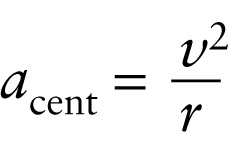Centripetal acceleration (3-17)
Question 1 of 3
Question
Centripetal acceleration: Magnitude of the acceleration of an object in uniform circular motion
{"title":"Centripetal acceleration Magnitude of the acceleration of an object in uniform circular motion","description":"Correct!","type":"correct","color":"#99CCFF","code":"[{\"shape\":\"rect\",\"coords\":\"1,64,28,104\"},{\"shape\":\"poly\",\"coords\":\"82,133\"}]"} {"title":"Speed of an object as it moves around the circle","description":"Wrong","type":"incorrect","color":"#ffcc00","code":"[{\"shape\":\"rect\",\"coords\":\"118,11,119,13\"},{\"shape\":\"rect\",\"coords\":\"172,27,208,69\"}]"} {"title":"Radius of the circle","description":"Incorrect","type":"incorrect","color":"#333300","code":"[{\"shape\":\"poly\",\"coords\":\"113,132\"},{\"shape\":\"rect\",\"coords\":\"173,96,204,132\"}]"}Review
As we learned in Section 3-8, an object that travels at constant speed v around a circular path of radius r—that is, an object in uniform circular motion—has an acceleration toward the center of the circle of magnitude:

